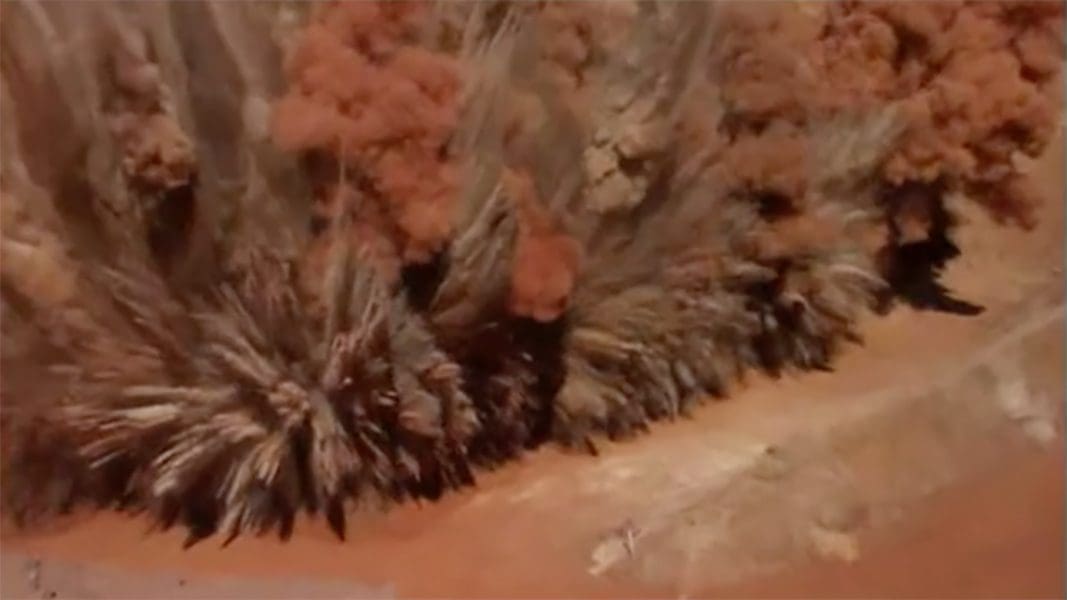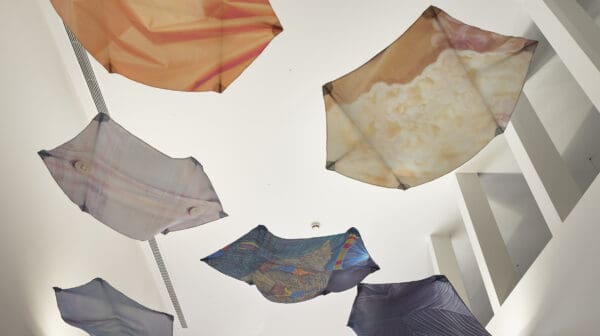The land has been prepared, pre-planted. Visible mounds in careful rows, as though saplings or cornstalks might push their green shoots up through the dirt. Instead, in slow motion, the earth turns liquid, a roiling ocean swell. Individual plumes erupt from each mound, for a moment like a neat row of whale spouts. Then the boundary between land and sky dissolves, and a dust cloud blooms across the screen.
In the next shot, a different quiet piece of land slowly explodes. And again. And again.
Brodie Ellis’s video work, A Crystal World, 2016, cuts together footage of Australian mining explosions, sourced online, into a slow motion sequence. As mesmerising as they are destructive, these rhythmic blooms of explosions are almost silent save for a soundtrack of clicks and rustles, clanks and rumbles, rising and falling throughout the film. The title is borrowed from a JG Ballard book, but it could just as easily be a description of what we see here: the crystallising of dust plumes, hanging in the air like a macro view of frozen water.
There is no context for the land we see erupting. It could be anywhere: any patch of earth razed bare and declared uninhabited, up for exploiting. Any history, knowledge or language once held in the soil is dispersed into the atmosphere, over and over.
The exhibition text draws links between Ellis’s work and both land art and abstract expressionism.
The former gives me pause. While it’s true that the Spiral Jetty, for example, involved a large-scale shifting of natural materials, can this footage of annihilations by mining companies – undoubtedly altering the land forever – possibly reference land art in any spirit other than the blackest irony? Emerging in the 1960s, the land art movement emerged in response to the increased commercialisation of art. At the other end of the scale, open-cut mining feeds the globalised market in which natural resources are stripped to their dollar value.
As for abstraction, this is The Crystal World’s tactic of seduction. We are lulled by the slow cycle of stillness and explosion; earth expanding frame by frame into a cloud, sinking back to stillness, erupting again. The rumble and roar of splitting earth is erased into near-silence. Instead, the soundtrack is lo-fi industrial: distant hands slap out a rhythm on a gallon drum, turn a crank-handle or bicycle chain into gentle whirring. There’s a low hum of electronic noise.
This work is an apt, if chilling, response to the reality of the Anthropocene. In cutting together this legacy of destruction, Ellis produces a cyclical lullaby to a dying world. The earth plumes rise and rise and rise. Hilltops, momentarily still, bloom crystal clusters. Clouds grow upwards like a plantation of giant pines. The whole earth is erupting, slowly, softly, inevitably. Annihilation has never been so gentle, like ink tendrils curling through water.
The Crystal World
Brodie Ellis
MARS Gallery
31 May – 23 June













